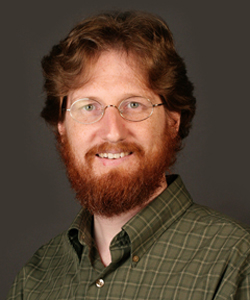
Kenyon Evans-Nguyen
Professor
Office: TECH 673 A
Education and Training:
- 1998 Maryville College, BA in Biochemistry; with David Glasgow
- 2005 UNC-Chapel Hill, Ph.D. in Analytical Chem; with Mark Schoenfisch
- 2008 Johns Hopkins, Postdoc in Mass Spec; with Bob Cotter
Research Interests:
Kenyon Evans-Nguyen and his students focus on the development of new technologies and methods in mass spectrometry for use in forensic chemistry. Mass spectrometers yield histograms (spectra) representing molecular masses that function as chemical "fingerprints" for identification. Forensic chemists are tasked with identifying unknown substances found at crime scenes. The most common types of evidence submitted to forensic chemists are drugs, explosives, and ignitable liquid residues (from potential arson cases).
Mass spectrometry is the most commonly used tool for identification in forensic chemistry; however, preparing samples obtained at crime scenes for analysis in a mass spectrometer can be a laborious process. We work to make the process or converting the solid evidence to a form that can be analyzed with mass spectometry faster and simpler.
The most common samples for analysis are powders suspected of containing drugs or explosives. These solids/powders may be bulk samples (a pile of powder) or barely visible residues, such as a baggie with cocaine residue or a fragment of an exploded pipe bomb with residual traces of explosive compounds. To prepare residues for analysis in a mass spectrometer, chemists usually use chemical solvents to extract the drug/explosive residues from the solid, which can be time-consuming and laborious. Alternatively, they may swab to mechanically capture particles from a solid surface and then analyze the swab in a mass spectrometer. Swabbing surfaces or performing chemical extraction ruins underlying evidence such as fingerprints and DNA. My students and I are working to streamline solid residue analysis with a mass spectrometer, avoiding both solvent preparation and swabbing steps.
We have been exploiting the properties of high voltage electricity and lasers to streamline solid residue analysis with a mass spectrometer. Students are using Van de Graaff generators which build up very high voltages at their surface to attract evidentiary residue particles from surfaces. They have used a handheld Van de Graaff generator marketed as a children’s toy (the Fun Fly Stick). A metal grid attached to the Fun Fly Stick can be “wanded” over a surface, without touching it, to pick up drug or explosive residues electrostatically. Because the surface or the evidence is not touched, possible fingerprint or DNA evidence on the surface can be preserved.
Other current students are working with a high-powered laser, which can be fired at a surface, ablating (i.e “exploding”) residue particles from the surface. The ablated particles can be captured and introduced into the mass spectrometer.
My students and are quite hands-on with the tools of analytical chemistry. In addition to learning how to run the mass spectrometers well, we build devices and parts to use with the mass spectrometers. Students often feel like it is a hybrid of chemistry and electronics/engineering. Students gain confidence with the instrumental tools of forensic science; in running them and in "tweeking"/repairing them.

American Academy of Forensic Sciences Meeting 2023

Field sampling marijuana

Hand sampling
Kenyon M. Evans-Nguyen*, Forensic Chemistry. ACS In Focus. American Chemical Society, 2021.
Kenyon M. Evans-Nguyen*, Amanda Rivera, Jannelys Fontanez-Adames, Fred Li, and Brian Mussleman “Solvent-Free, Non-Contact Electrostatic Sampling for Rapid Analysis with Mass Spectrometry: Application to Drugs and Explosives” Journal of the American Society for Mass Spectrometry, 31 (2020), 2237-2242.
Kenyon Evans-Nguyen*, Ashley Stelmack, Phoebe C. Clowser, Jessica M. Holtz, and Christopher C. Mulligan “Fieldable Mass Spectrometry for Forensic Science, Homeland Security and Defense Applications” Mass Spectrometry Reviews, (2020).
Kenyon Evans-Nguyen* “An Introduction to Instrumentation Used on Fire Debris and Explosives Analysis” in Katherine Hutches and Kenyon Evans-Nguyen (Eds.) Analysis of Fire Debris and Explosives, Springer Nature, Switzerland (2019).
Kenyon Evans-Nguyen and Katherine Hutches (Authors, Eds.) Analysis of Fire Debris and Explosives, Springer Nature, Switzerland (2019).
Kenyon M. Evans-Nguyen*, Tiffanie Hargraves, Amanda Quinto, “Immunoaffinity Nanogold Coupled with Direct Analysis in Real Time (DART) Mass Spectrometry for Analytical Toxicology” Analytical Methods, 9 (2017), 4954-4957.
Hilary Brown, Berk Oktem, Vladimir Doroshenko, Kenyon Evans-Nguyen*, “Direct Analysis in Real Time (DART) and a Portable Mass Spectrometer for Rapid Identification of Common and Designer Drugs On-Site”, Forensic Chemistry, 1 (2016), 66-73.
K. M. Evans-Nguyen*, J. Gerling, H. Brown, M. Miranda, A. Windom, and J. Speer, “Towards universal ambient ionization: direct elemental analysis of solid substrates using microwave plasma ionization”, Analyst 141 (2016), 3811-3820 (Invited publication for the Emerging Investigators Themed Issue).
Kenyon M. Evans-Nguyen*, Amanda Quinto, Tiffanie Hargraves, Hilary Brown, Jennifer Speer, and David Glatter, “Transmission mode desorption electrospray ionization (TM-DESI) for simultaneous analysis of potential inorganic and organic components of radiological dispersion devices (RDDs)” Analytical Chemistry 85, (2013), 11826 -11834.
Robert J Cotter*, Kenyon M. Evans-Nguyen, Heng Zhu, and Sheng-Ce Tao, “Protein microarrays for mass spectrometry and methods for use therefor” Application No. WO 2009-US34547 Feb 19, 2009. Published.
Kenyon M. Evans-Nguyen, Sheng-Ce Tao, Heng Zhu, and Robert J Cotter*, “Protein Arrays on Patterned Porous Gold Substrates Interrogated with Mass Spectrometry: Detection of Peptides in Plasma” Analytical Chemistry 80 (2008), 1448-1458.
Kenyon M. Evans-Nguyen, Ryan R. Fuierer, Brian D. Fitchett, Lauren Tolles, John C. Conboy, and Mark H. Schoenfisch*, “Changes in Adsorbed Fibrinogen Layers upon Conversion to Fibrin” Langmuir 22 (2006), 5115-5121.
Kenyon M. Evans-Nguyen, Lauren R. Tolles, Oleg V. Gorkun, Susan T. Lord, and Mark H. Schoenfisch*, “Interactions of Thrombin with Fibrinogen Adsorbed on Methyl-, Hydroxyl-, Amine-, and Carboxyl-Terminated Self-Assembled Monolayers,” Biochemistry 44 (2005), 15561-15568.
K.M. Evans-Nguyen and Mark H. Schoenfisch*, “Fibrin Formation at Model Surfaces: Influence of Surface Properties,” Langmuir 21 (2005), 1691-1695.
Brendan Minick and Kenyon M. Evans-Nguyen, “Sampling of Refractory Materials and Metals Using Laser Ablation and Electrostatic Capture, and Analysis of Captured Particles Using Thermal Desorption Electrospray Ionization (TD-ESI) and an Ion Trap Mass Spectrometer,” 75th Annual American Academy of Forensic Sciences Annual Meeting, Orlando, FL, February 2023 (Poster Presentation)
Clarissandra Braun and Kenyon M. Evans-Nguyen, “Solvent Effects in the Analysis of Explosives,” 75th Annual American Academy of Forensic Sciences Annual Meeting, Orlando, FL, February 2023 (Poster Presentation)
Kenyon Evans-Nguyen, Madison Autrey, Brendan Minick, and Shane Kullen, “Optimization and enhancement of electrostatic capture, a solvent-free, non-contact surface sampling method for mass spectrometry” 70th ASMS Conference on Mass Spectrometry, Minneapolis, MN, June 2022 (Poster Presentation)
Tiffany M. Matyja, John A. Struss, and Kenyon M. Evans-Nguyen, “Cannabinoid Content in Commercially Available Oils,” 72nd Annual American Academy of Forensic Sciences Annual Meeting, Anaheim, CA, February 2020 (Poster Presentation)
Kenyon Evans-Nguyen, Abigail Smola, Gaston Merideth II, Kayla M Whitehouse, Tiffany Matyja, and Micheala Le Gendre, “Reactions and Fragmentation in a Microwave Plasma Jet Ionization Source” 67th ASMS Conference on Mass Spectrometry, Atlanta, GA, May 2019 (Poster Presentation)
Ashley Windom, “Profiling Reaction Intermediates and By Products in Illicit Synthetic Drug Samples Using Direct Analysis in Real Time (DART) and an Ion Trap Mass Spectrometer,” 69th Annual American Academy of Forensic Sciences Annual Meeting, New Orleans,LA, February 2017 (Poster Presentation)
Gaston Merideth II,* Kelsey May,* and Kenyon Evans-Nguyen, “Compact Laser Ablation Microwave Plasma Ionization for Ambient Molecular and Atomic Analysis,” 65th ASMS Conference on Mass Spectrometry, Indianapolis, IN, May 2017 (Poster Presentation)
Kenyon M. Evans-Nguyen, Jon Gerling, and Ashley Windom,* “A Microwave Plasma for Simultaneous Molecular and Atomic Ambient Ionization of Solids,” 64th ASMS Conference on Mass Spectrometry, San Antonio, TX, May 2016 (Poster Presentation)
Kenyon M. Evans-Nguyen, “Fieldable Mass Spectrometry in Forensic Chemistry and Toxicology,” 68th Annual American Academy of Forensic Sciences Annual Meeting, Las Vegas,NV, February 2016 (Oral Presentation-Workshop)
Kenyon M. Evans-Nguyen, Ashley Windom,* Colleen Quinn,* Hilary Brown,* Spiros Manolakos, and Theresa Evans-Nguyen, “The Microwave Plasma Torch as a Combined Molecular and Atomic Ionization Mass Source,” 63rd ASMS Conference on Mass Spectrometry, St. Louis, MO, May 2015 (Poster Presentation)
Kenyon M. Evans-Nguyen, Hilary Brown,* Jennifer Speer,* and Jon Gerling, “Towards Fieldable Technologies for Comprehensive Forensic Analysis: Laser Ablation-Microwave Plasma Torch and Multimode Ambient Ionization Mass Spectrometry,” 62nd ASMS Conference on Mass Spectrometry, Baltimore, MD, May 2014 (Poster Presentation)
Kenyon Evans-Nguyen, Ashley Windom, Spiros Manolakos, and Theresa Evans-Nguyen, “Combining molecular and atomic ambient ionization technologies for complete sample characterization”, 250th ACS National Meeting & Exposition, Boston, MA, August 2015 (Oral Presentation)
Kenyon Evans-Nguyen, Hilary Brown,* Vladimir Doroshenko, Hanany Flores Duron,* Jon Gerling, Berk Oktem, and Jennifer Speer,* “Towards fieldable atomic and molecular mass spectrometry technologies”, PittCon 2015 Conference - Forensic Analysis in the Lab and Crime Scene Symposium, New Orleans, LA, March 2015 (Oral Presentation-Invited Speaker)
Kenyon Evans-Nguyen, Berk Oktem, Hilary Brown,* and Vladimir Doroshenko, “Rapid Drug Identification in the Field Using Direct Analysis in Real Time (DART) and a Portable Ion Trap Mass Spectrometer”, 67th Annual American Academy of Forensic Sciences Annual Meeting, Orlando, FL, February 2015 (Oral Presentation)
Kenyon Evans-Nguyen, Hilary Brown*, Berk Oktem, Jennifer Speer*, and Hanany Flores Duron,* “Elemental and Organic Forensic Mass Spectrometry using Fieldable Technologies”, ASMS Sanibel Conference on Security and Forensic Applications of Mass Spectrometry, Clearwater Beach, FL, January 2015 (Oral Presentation-Invited Speaker)
Kenyon Evans-Nguyen, Theresa Evans-Nguyen, Friso van Amerom, Hilary Brown,* Jennifer Speer,* and Spiros Manolokos “Plasma Ionization and Portable Mass Spectrometry for Post-Detonation Nuclear Forensics”, FACSS-SciX 2014, Reno, NV, September 2014 (Oral Presentation-Invited Speaker)
Kenyon M. Evans-Nguyen, Hilary Brown, and Jennifer Speer*, “Simultaneous Elemental, Inorganic, and Organic Analysis of Forensic Samples using Multi-mode Ambient Ionization Mass Spectrometry”, International Forensic Research Institute 3rd Annual Forensic Science Symposium, Miami, FL, May 2014 (Oral Presentation-Invited Speaker)
Hilary Brown, Jennifer Speer, John Gerling, and Kenyon Evans-Nguyen, “A Mass Spectrometer for Elemental Analysis Based on Fieldable Technologies”, PittCon 2014 Conference, Chicago, IL, March 2014 (Poster Presentation)
Jennifer Speer, Brian Sanchez, Hilary Brown, and Kenyon Evans-Nguyen, “Ambient Ionization Mass Spectrometry for Simultaneous Detection of Organic and Inorganic Components of Gunshot Residue (GSR) and Explosives,” PittCon 2014 Conference, Chicago, IL, March 2014 (Poster Presentation)
Kenyon M. Evans-Nguyen, Hilary Brown, and Jennifer Speer, “Simultaneous Elemental, Inorganic, and Organic Analysis of Forensic Samples using Multi-mode Ambient Ionization Mass Spectrometry”, 66th Annual American Academy of Forensic Sciences Annual Meeting, Seattle, WA, February 2014 (Oral Presentation)
Jonathan Marks, Kenyon Evans-Nguyen, and Margaret Donohoe, “Functionalized Nanogold Assisted Extraction and Detection of Trace Forensic Evidence using DART-Tandem Mass Spectrometry,” 245th ACS National Meeting & Exposition, New Orleans, LA, April 2013 (Poster Presentation)
Margaret Donohoe, Jonathan Marks, and Kenyon Evans-Nguyen, “Rapid, definitive analyses of drugs in complex matrices using nanogold extraction coupled with DART-tandem spectrometry,” 245th ACS National Meeting & Exposition, New Orleans, LA, April 2013 (Poster Presentation)
Kenyon M. Evans-Nguyen, Jonathan Marks, Margaret Donohoe, and Richard Garcia, “Mixed-mode Nanogold Extraction Coupled with DART-MS/MS Mass Spectrometry for Forensic Toxicology Analyses,” 60th ASMS Conference on Mass Spectrometry, Vancouver, British Columbia, May 2012 (Poster Presentation)
Amanda Quinto, Tiffanie Hargraves, and Kenyon Evans-Nguyen, “Rapid, Simultaneous Analysis of Organic and Inorganic Substances in Post-Detonation Radiological Debris Using Ambient Ionization Techniques and Mass Spectrometry,” 60th ASMS Conference on Mass Spectrometry, Vancouver, British Columbia, May 2012 (Poster Presentation)
Kenyon M. Evans-Nguyen, Tiffanie Hargraves, Amanda Quinto, and Jennifer Devorak, “Porous Gold Substrates for Rapid Extraction of Drugs Prior to MS Analysis,” 59th ASMS Conference on Mass Spectrometry, Denver, CO, June 2011 (Poster Presentation)

